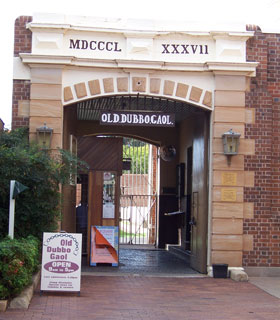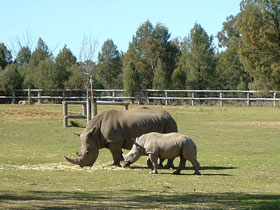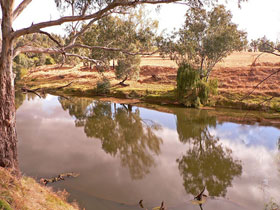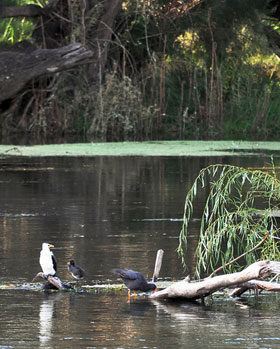|

Old Dubbo Gaol

Taronga Western Plains Zoo

Dubbo Court House

Macquarie River

Butlers Falls
|
Located at the intersection of the Mitchell, Newell and Golden highways in the Central West Region of New South Wales, Dubbo is considered the cross-roads of New South Wales. It is linked by national highways north to Brisbane, south to Melbourne, east to Sydney and Newcastle, and west to Broken Hill and Adelaide. Dubbo is also a major road and rail freight hub.

Taronga Western Plains Zoo
Where is it?: New South Wales: Central & Far West. Dubbo is 420 km north west of Sydney on the New South Wales western plains. Dubbo is the terminus of a daily CountryLink XPT train service which operates to and from Sydney.
Things to see and do:
Taronga Western Plains Zoo is home to various species of endangered animals, including the White, Black and Indian Rhinoceros', and runs a successful breeding program for a number of endangered species. The animals are housed in spacious open-range moat enclosures, grouped according to their continent of origin.
Town attractions include the historic Dundullimal Homestead and the historic Old Dubbo Gaol in the middle of the commercial centre of Macquarie Street. The Western Plains Cultural Centre includes four gallery exhibition spaces, two Museum exhibition spaces and a Community Arts Centre. Other places of interest around Dubbo include the Dubbo Observatory, Garling Gallery, Jedda Boomerangs, Western Plains Cultural Centre, and a host of boutique wineries Boora Estate Wines, Red Earth Estate Vineyard and Tombstone Estate Vineyard & Rose Gardens.
Surrounding area:
A canoe/kayak trip down one of NSW's inland rivers enables you to enjoy the true beauty of our vast river systems. There are many Crown Land reserves along the trail where you can camp overnight or stop for a well-earned lunch break. The Macquarie River Canoe & Kayak Trail covers the stretch of the Macquarie River between Dubbo and Wellington.
Macquarie River Trails are designed to let you explore the many attractions and treasures of this rich farming region supported by the Macquarie River in central western NSW. There are five trails to choose from - heritage, nature, river, produce and cycle - which visitors to a diverse number of locations between Lake Burrendong to the Macquarie Marshes. More >>
About Dubbo
History: Evidence of habitation by Indigenous Australians dates back approximately 40,000 years. John Oxley was the first European to report on the area now known as Dubbo in 1818. The first permanent settler in the area was Robert Dulhunty, described as one of the wealthiest citizens in the Australian colony at the time. There are records of squatters being given permission to set up large sheep and cattle stations in the area in 1824 but these were not maintained. Dulhunty occupied a property, known as Dubbo station, from the early 1830s on a squatting basis. With the passing of the Squatting Act in 1836 he took out a licence on the property.
Dulhunty showed an affinity with Indigenous Australians, his party included some 40 Aborigines and he favoured using Aboriginal names for properties, including Dubbo. Dubbo is now thought to be a mispronunciation of the local Wiradjuri word "Thubbo" but because of a lack of precise records from Dulhunty at the time and an incomplete knowledge of the Wiradjuri language today there is some conjecture over the word's meaning. A popular current theory is the word means "red earth," consistent with the local landscape. It is also possible that Thubbo is Wiradjuri for "head covering" - a theory put forward to support this name is that the shape of Dulhunty's house may have looked like a hat to the local people.
Dundullimal Homestead is a farmhouse from that period, built around 1840 by John Maugham on his 11,000 ha sheep station. The building is one of the oldest homesteads still standing in western NSW and today is open to visitors.
In 1846, due to the number of settlers in the area, the government decided to establish a courthouse, police station and lock-up in the Dubbo area. A constables residence was completed in 1847 and a wooden slab construction courthouse and lock-up in early 1848. By this time the settlement had only four buildings; the constables residence, courthouse and lock-up, a store and an inn.
Due to the lack of title for the land, in 1848 the storekeeper, Jean Emile Serisier, organised a petition asking for a land sale of town allotments. The plan was presented to the colony's Surveyor General in May 1849 by surveyor G. Boyle White. The settlement was gazetted as a village in November 1849 with the first land sales taking place in 1850. Population growth was slow until the Victorian gold rush of the 1860s brought an increase in north-south trade. The first bank was opened in 1867. Steady population growth saw the town proclaimed a municipality in 1872, when its population was 850. The coming of the railway in 1881 resulted in another boom period and by 1897 Dubbo had a general store, Carrier Arms, a slab courthouse, a gaol and a police hut. Dubbo was officially proclaimed a city in 1966.
|